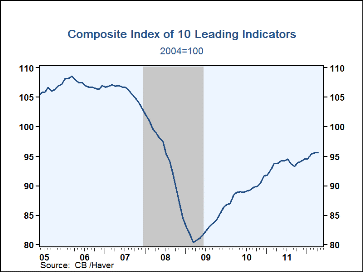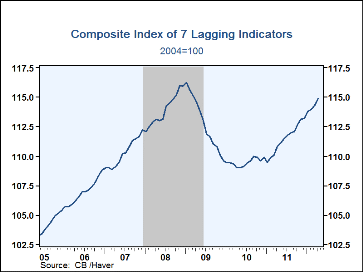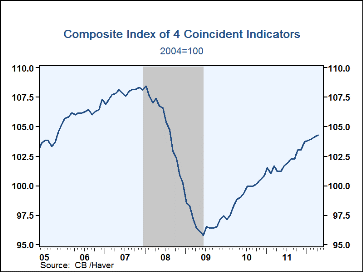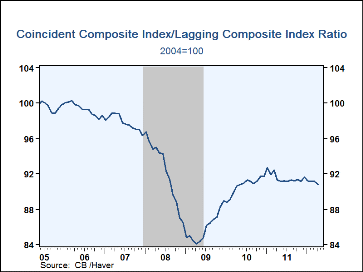 Global| May 17 2012
Global| May 17 2012U.S. Leading Indicators Dip
by:Tom Moeller
|in:Economy in Brief
Summary
The Leading Economic Indicator index from the Conference Board slipped 0.1% last month after an unrevised 0.3% increase during March. A 0.1% increase had been expected. Just 50% of the component series rose in the last two months [...]
The Leading Economic Indicator index from the Conference Board slipped 0.1% last month after an unrevised 0.3% increase during March. A 0.1% increase had been expected. Just 50% of the component series rose in the last two months versus 80% in February. Nevertheless, that remained improved from last September when just 25% gained. A steeper interest rate yield curve and a longer workweek had the most meaningful positive effects on the overall leading index last month. A rise in initial claims for jobless insurance, lower building permits and easier consumer expectations had meaningful negative effects. The separate Leading Credit Index slipped for the fourth straight month and indicated tighter conditions versus the easy state of last summer and fall.
The index of coincident indicators again rose 0.2% as all of the components improved. Higher manufacturing & trade sales, increased payroll employment, improved personal income and higher industrial production had positive effects on the series.
The index of lagging indicators rose 0.5% due mostly to higher C&I loans outstanding.
Another leading economic series is the ratio of coincident-to-lagging indicators. It measures how the economy is performing versus its excesses and it's declined in three of the last four months.
The Conference Board figures are available in Haver's BCI database; the components are available there, and most are also in USECON. The forecast figure for the Consensus are in the AS1REPNA database. Visit the Conference Board's site for coverage of leading indicator series from around the world.
A Perspective on Modern Business Cycle Theory from the Federal Reserve Bank of Richmond is available here.
| Business Cycle Indicators (%) | Apr | Mar | Feb | Y/Y | 2011 | 2010 | 2009 |
|---|---|---|---|---|---|---|---|
| Leading | -0.1 | 0.3 | 0.7 | 1.9 | 5.1 | 7.6 | -12.8 |
| Coincident | 0.2 | 0.2 | 0.1 | 3.1 | 2.8 | 2.5 | -7.7 |
| Lagging | 0.5 | 0.3 | 0.2 | 3.7 | 1.8 | -2.9 | -1.0 |
Tom Moeller
AuthorMore in Author Profile »Prior to joining Haver Analytics in 2000, Mr. Moeller worked as the Economist at Chancellor Capital Management from 1985 to 1999. There, he developed comprehensive economic forecasts and interpreted economic data for equity and fixed income portfolio managers. Also at Chancellor, Mr. Moeller worked as an equity analyst and was responsible for researching and rating companies in the economically sensitive automobile and housing industries for investment in Chancellor’s equity portfolio. Prior to joining Chancellor, Mr. Moeller was an Economist at Citibank from 1979 to 1984. He also analyzed pricing behavior in the metals industry for the Council on Wage and Price Stability in Washington, D.C. In 1999, Mr. Moeller received the award for most accurate forecast from the Forecasters' Club of New York. From 1990 to 1992 he was President of the New York Association for Business Economists. Mr. Moeller earned an M.B.A. in Finance from Fordham University, where he graduated in 1987. He holds a Bachelor of Arts in Economics from George Washington University.










